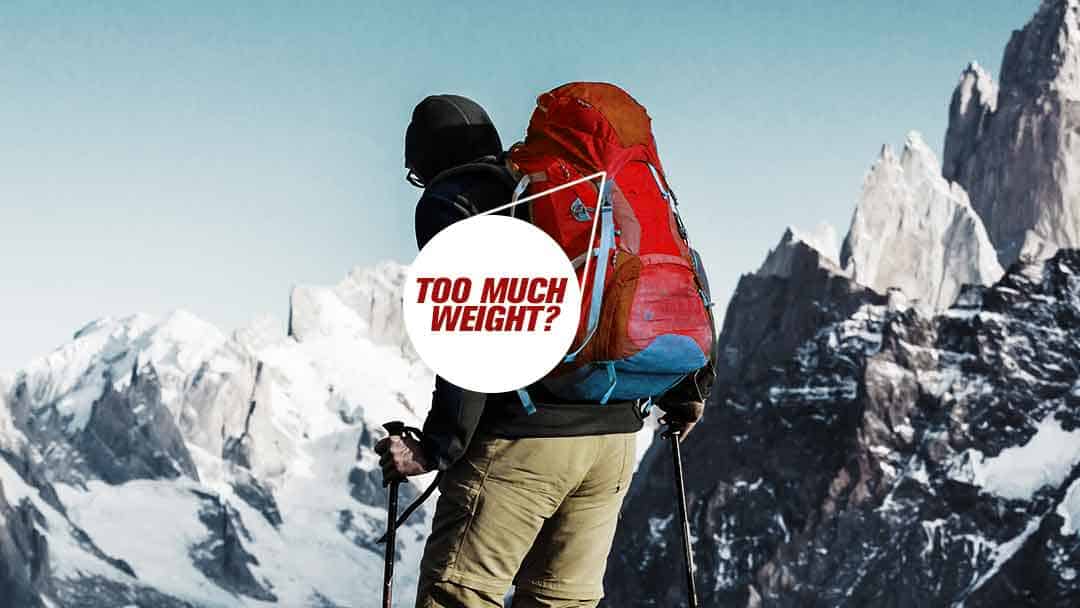Fastpacking Pack Weight | What’s Too Much?

As an Amazon Associate we earn from qualifying purchases made on our website. If you make a purchase through links from this website, we may get a small share of the sale from Amazon and other similar affiliate programs. You can read our complete legal information for more details. By using this site, you agree the information contained here is for informational purposes only. For specific medical questions, consult your doctor. NO information on this site should be used to diagnose, treat, prevent or cure any disease or condition.
Fastpacking combines trail running with ultralight backpacking to minimize the load on your back. For example, you can walk uphill, jog on level ground, and run downhill.
Some fast packers manage to keep their gear under 10 pounds, while others strive for no more than 15 pounds. But really, the main factors are how much you can run with safely in your fastpack, how far you are going, and what you need to take with you to stay safe.
The Low Down on Fastpacking
There is no expectation of staying in mountain huts or other forms of lodging, so participants are encouraged to bring only the bare necessities, such as a sleeping bag and tent, in their lightweight packs.
While staying in hotels and B&Bs is not cheating, it is rarely done because one of the beauties of fastpacking is being in nature.
It is possible to complete fastpacking routes independently, with minimal help from others, or with total aid from a support crew.
Again the amount of help you have decided upon will determine how much you will have to carry.
The difference between supported and unsupported fast packers is that the former will drop off caches of supplies at strategic points along the route they plan to take, as discussed in our fastpacking guide.
Fastpacking requires long-distance travel with a pack over multiple days, which demands stamina and determination. Do not make things even harder by packing too much.
Established, well-traveled long-distance paths are often used because being lost in the wilderness for a long time with minimal extra food and clothing may quickly become risky.
On the other hand, you can go wherever you choose with a fastpack, which is its beauty.
If you are newer to this type of fastpacking, you will want to read this fastpacking safety article.
Base weight
Often when you hear about what weight people are carrying, it seems shockingly low, and you will be amazed how much more your fastpack might weigh. This is because they will probably be talking about their base weight.
The base weight is the weight of the items that basically remains the same for every fastpacking trip.
People try to get this weight as low as possible as it contains the essentials, like tents, sleeping mats, sleeping bags, and the fastpacking bags themselves.
Base weight does not include your food, water, and the clothes you are wearing. These are more variable depending on the trip; therefore, they are not included in the base weight.
Now that you understand the basics of base weight, it’s time to check off your gear list with this article, “The Ultimate Fastpacking Kit List.”

Fastpacking weight tips
The question then becomes, how much should one take when fastpacking?
Optimal fastpacking weight has not been formally defined. It’s not so much a number as a state of mind. You have to make up your mind on what you’re willing to cut back on.
If you keep in mind that the less you weigh, the faster you can travel over greater distances, and you’ll be well on your way to finding your sweet spot.
The caveat is that if you have been training and have more cardio, stamina, and strength, then it’s possible to add more weight. This article discusses my personal training regimen for fastpacking.
When you trust your own good sense rather than your gear, you can hike without worrying about your health, safety, or comfort.
If you’re ready to lighten your burden for the trail, consider the following suggestions.
Know your current base weight
Use a luggage or kitchen scale to determine the weight of your base items. To determine your current base weight, subtract the weight of your consumables (food, drink, and fuel) from the total weight of everything on your back.
Knowing your initial weight will allow you to set realistic goals for improvement.
Replace older gear with lighter new gear
Consider the weight of each item carefully as you choose new and replacement gear. Look for lightweight alternatives that nonetheless get the job done.
It would help if you tried to make your sleeping bag lighter without sacrificing comfort. To understand what most people have in their kit, you need to read: How Much Does Fastpacking Cost? Gear Breakdown & List.
Make changes gradually
Lighter equipment is typically more expensive, so it may make sense to lighten your burden with light equipment upgrades gradually. Replace each heavy fastpacking item with a lighter but more expensive alternative.
Recognize the tradeoffs
Though ultralight gear weighs less overall, it may not hold up as well or be as comfortable as heavier options in the long run.
It seems counterproductive that fastpacking items are generally more expensive but do not last as long.
That is just the nature of the beast; if you don’t like it, just do regular hiking or running separately, and you might get more value for money.
Also, make sure your tent isn’t weighing you down. I share my top 6 tents and why they are great for certain types of fastpacking trips here.

Fastpacking shops
It would be much easier if there were dedicated fastpacking shops where you can buy everything you need, but alas, there are not… I should open one, maybe.
Instead, you have to shop like a running and ultralight hiker at the same time. This means you will probably make mistakes, but you will learn from your errors and eventually get the perfect fastpacking kit.
Fastpacking is too niche and isn’t sporty enough yet to have dedicated stores, but it is becoming more popular, so you will see more companies dedicating time and effort to the market.
While you may not yet see dedicated Fastpacking brands, you will start to see established running and hiking brands offering bundles or claiming their goods are fastpacking appropriate.
For example, the running brand Ultimate Direction has a range of running vests appropriate for fastpacking; I use the Fastpack35.
Also, the clothing brand Montane in the U.K. has a fastpacking bundle page, listing all their hiking and running clothing that is light and very packable, which they recognize is perfect for fastpacking.
And one more mention. I have five ultralight pillows that I use on rotation, and you can check those out here.
Conclusion
There is no perfect base weight… what I can carry for 100 miles of fastpacking could be totally different from what you can carry for 100 miles.
I could be running past flat lakes; you could be running up and down mountains. I could be running in the sun; you would be running in the rain.
It all depends and can change from trip to trip.
The tradeoff is you need to carry as light as possible without negatively impacting your safety. This you will learn from experience. If you are wanting to increase your Fastpacking education, check out this Ultimate Fastpacking Guide.



